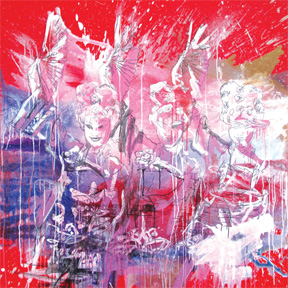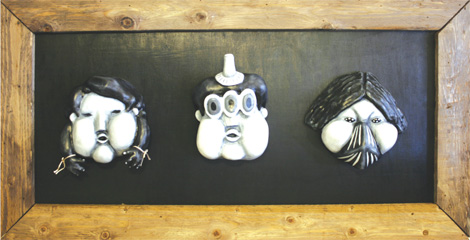Street-smart art
Updated: 2009-12-12 07:04
By Vickie Chan(HK Edition)
|
|||||||||

Walking around Hong Kong one of the first things one observes is the iconic, world-famous skyline. You won't, however, see much graffiti - nor, for that matter, public art. In fact, in Hong Kong, architecture substitutes for fine art for the public. Despite the numerous buildings and complexes created by real estate magnates, there are few significant pieces of public artwork or spaces on which people can create a discourse or interact with their environment. Despite this, instances in which people are invited to interact with public art appear to be a huge success. Last year, Carrie Chau's exhibition at Times Square, which saw the outside podium turned into a winter wonderland where people could interact with her inviting sculptures, proved a success. The public eased into the space - with regular queues forming as people waited to pose for photographs alongside the sculptures.
As a result of the lack of public art spaces, some artists are turning to new ways of creating their own discourses in the public eye. Perhaps this is a reaction to the limited spaces for emergent artists to display their work and to Hong Kong's intense commercial visual communications. These young artists are beginning to get attention from galleries both in Hong Kong and beyond.
Local duo Graphic Airlines are among those who look at public spaces as their stage. Starting as graphic designers, the pair have a widely-varied resume, including album artwork for pop singer/movie star Leon Lai. But about four years ago, feeling disenchanted with the Hong Kong arts scene, they started to notice stickers posted in the streets. "We were curious about what they were for so we started to draw some - just small ones... We got to know other street artists, we grouped together and did projects together!" The pair soon became familiar with the small street-art scene in Hong Kong, even though they don't create graffiti. "It's quite different because we did not start at the beginning in Street art, it's not traditional graffiti. We just put our drawings in the street," as a way of making use of the space around them and to benefit the public, they said, adding, "It's very boring here, too commercial. We want to put something more interesting in the streets; for public space we wanted something different that more people can see. Some of our work has a message and we can tell it to the people."
In many ways, Graphic Airlines are about transcendence. "We are called Graphic Airlines because we can do our work without boundaries, in any media and reach different kinds of people." The same sentiment can be expressed about commissioned public art - such as Gormley's Fourth Plinth in Trafalgar Square, London in which the public could watch or apply to perform on the plinth for one hour, and become part of the art. Despite understanding that some people find graffiti, stickers and posters a nuisance, Graphic Airlines believe "it's most challenging and interesting, the impact is positive." Creating cute characters that appeal to all ages - "maybe it's easier to accept," than traditional graffiti. The characters represent "people. In our civilized world, we have everything we want. We eat too much; we own too much in the material world. But we are not happy - (the characters) are boring and unfeeling to everything happening around them," they suggested, yet their works are delivered with humor, brightening up the environment as they beg the public to interact with art, look at it, and enjoy their daily environments.
L1ES ONE moved to Hong Kong three years ago because he wanted to know more about China and regions beyond. He was, however, surprised to find "the art scene is really small here - I arrived thinking the art scene would be like the architecture, but it's not as sophisticated as that! I was a little saddened." This hasn't prevented him from developing his work and falling in love with the area. Learning English during his time here - but not Chinese - the region holds intrigue for him. "I've been really impressed with Asian culture, especially Chinese. I've been to Guangzhou and Shanghai a lot ... For me, Chinese identity is blurred because I don't speak Chinese - so there are a lot of things I can't really understand, but I love it because there are a lot of things I escape from, I don't know all parts of the culture," he said.
Coming from a poor, mixed race background - his father is Algerian and his mother Italian - influenced him: "I always try to mix things you don't (usually) see together - like a traditional icon and a kind of painting style, or opera and factories. Maybe the idea is that everything can be mixed and be together if you respect everything" - an idea that he clearly believes. "I am an immigrant's son; one of my jobs is to promote the ghetto class!" It is apparent that this has influenced his work and his passion for China - his ethic is one of art for everyone, or even art as a vehicle to transcend differences. "I have an easy vision of art. You don't have to make art to be an artist, your lifestyle can be art. For me everyone is an artist."
Juxtaposing images of traditional or cultural China - such as Chinese opera - with contrasting images of modernity - such as young factory workers, harkening to mass-production and consumption - L1ES creates a dialogue between two different realms of society that co-exist and cross over but rarely come together. He repeatedly uses the image of one worker as a signifier, saying, "for me she's the Chinese icon - she's young, she's curious." He adds, "I try to mix traditional culture with modern things. This is my tribute to this kind of life; if I had been born in China I would come from this kind of social class."

Despite the source of his visual inspiration, his style has a more western aesthetic linked to Street art, even though it's not a title that he is quite comfortable with. "In French we call it Culture Urbaine. It seems to me there's Culture, and then there's Urban Culture. Why are they separated? There is nothing from the street here, we're in a gallery. As an artist I come from this movement, I learned everything from this movement but I don't think you have to separate or make distinctions between the production and the artist. I have four main movements in my painting: Pop Art, graffiti, German Minimalists and Italian Futurists."
Nonetheless, L1ES started painting outside, public spaces when he was just ten. "I call this style Evolutionist Graffiti. I learned to keep the energy and spontaneity of graffiti but without the limits of the techniques and subject. I want to push this to make something more personal." Preferring bigger, outdoor spaces, he says. "Canvas is too limited. If I have to use it, I prefer something huge, like 2 or 3 meters... I like to continue on the wall if I can. I have painted walls that are 700 meters." That gives him the added bonus of his work becoming visible to the world around it.
In a society where gallery-going is not intrinsic to the culture, Street art can be used as a vehicle to brighten public environments and provide a canvas for local artists - whose work is made with thought and care for the viewers. With the current lack in public art, funding and affordable spaces for emergent artists to show their work, Street art in Hong Kong has transcended the boundaries within which it was first formed to become a movement that offers something to everyone.
In order to "create a dialogue between the Western and Asian Street art scene," Schoeni Gallery has invited Graphic Airlines, L1ES ONE, along with Friendly Liu, who creates charming illustrations heavily influenced by Chinese calligraphy, to participate in an international exhibition as part of the Adapta satellite project. These emergent artists are exhibiting alongside well-known Street artists such as Swoon from New York and Cept from London. Their works will be exhibited until January 3, 2010.
|
Clockwise from top: M1NGONG-OPERA by L1ES ONE; Ugly People, Beautiful Freaks by Graphic Airlines; Moon from the Mid Autumn Series by Friendly Liu. Photos courtesy of the artists |
(HK Edition 12/12/2009 page7)
